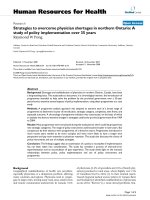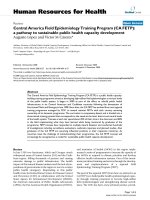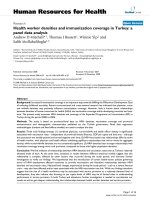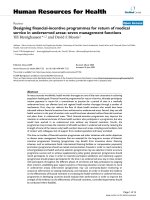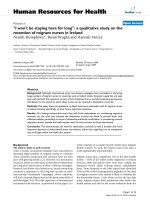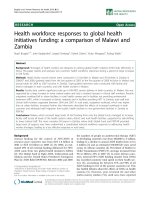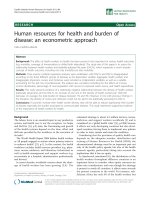báo cáo sinh học:" Sharing best practices through online communities of practice: a case study" potx
Bạn đang xem bản rút gọn của tài liệu. Xem và tải ngay bản đầy đủ của tài liệu tại đây (290.68 KB, 8 trang )
CAS E STU D Y Open Access
Sharing best practices through online
communities of practice: a case study
Annamma Udaya Thomas
1*
, Grace P Fried
2
, Peter Johnson
1
, Barbara J Stilwell
3
Abstract
Introduction: The USAID-funded Capacity Project established the Global Alliance for Pre-Service Education (GAPS)
to provide an online forum to discuss issues related to teaching and acquiring competence in family planning,
with a focus on developing countries’ health related training institutions. The success of the Global Alliance for
Nursing and Midwifery’s ongoing web-based community of practice (CoP) provided a strong example of the
successful use of this medium to reach many participants in a range of settings.
Case description: GAPS functioned as a moderated set of forums that were analyzed by a small group of experts
in family planning and pre-service education from three organizations. The cost of the program included the effort
provided by the moderators and the time to administer responses and conduct the analysis.
Discussion and evaluation: Family planning is still considered a minor topic in health related training institutions.
Rather than focusing solely on family planning competencies, GAPS members suggested a focus on several
professional competencies (e.g. communication, leadership, cultural sensitivity, teamwork and problem solving) that
would enhance the resulting health care graduate’s ability to operate in a complex health environment. Resources
to support competency-based education in the academic setting must be sufficient and appropriately distributed.
Where clinical compe tencies are incorporated into pre-service education, responsible faculty and preceptors must
be clinically proficient. The interdisciplinary GAPS memberships allowed for a comparison and contrast of
competencies, opportunities, promising practices, documents, lessons learned and key teaching strategies.
Conclusions: Online CoPs are a useful interface for connecting developing country experiences. From CoPs, we
may uncover challenges and opportunities that are faced in the absorption of key public health competencies
required for decreasing maternal mortality and morbidity. Use of the World Health Organization (WHO)
Implementing Best Practices Knowledge Gateway, which requires only a low bandwidth connection, gave
educators an opportunity to engage in the discussion even in the most Internet access-restricted places (e.g.
Ethiopia). In order to sustain an online CoP, funds must come from an international organization (e.g. WHO
regional office) or university that can program the costs long-term. Eventually, the long-term effectiveness and
sustainability of GAPS rests on its transfer to the members themselves.
Introduction
A community of practice (CoP) provides a means of gath-
ering and sharing information. Popular in business, a CoP
is an informal, self-selected group of people who share
expertise and who are brought together to solve problems
and share knowledge [1]. Evaluators of CoPs hav e noted
that discussion within a CoP tends to be less constrained
than discussions generated by more conventional meth-
ods, allowing for creative and novel solutions to old
problems [1]. However, shared information within a CoP
is frequently experiential, which may limit the validity of
the evidence being shared [2].
The Capacity Project was a USAID-funded global
initiative with multiple activities focused on strengthen-
ing human resources for health. The Project was led by
IntraHealth International in collaboration with partners
IMA World Health, Jhpiego, Liverpool Associates in
Tropical Health (LATH), Management Sciences for
Health (MSH), PATH and Training Resources Group,
Inc. (TRG). In the pre-service edu cation (PSE) arena, the
Project has focused on strengthening key areas, such as
* Correspondence:
1
Jhpiego Corporation, 1615 Thames Street, Baltimore, MD 21212, USA
Full list of author information is available at the end of the article
Thomas et al. Human Resources for Health 2010, 8:25
/>© 2010 Thomas et al; licensee BioMed Central Ltd. This is an Open Access article distributed under the terms of the Creative Commons
Attribution License (http://creati vecommons.org/licenses/by/2.0), which permits unrestricted use, distribution, and reproduction in
any medium, provided the original work is properly cited.
family planning (FP) and HIV/AIDS, especially to address
issues of poorly developed clinical competencies. This
has included facilitating systems for developing and
implementing competency-based curricula and harmoni-
zation of FP and HIV/AIDS content for pre-service and
in-service training, especially of nurses and midwives [3].
The Capacity Project established the Global Alliance for
Pre-Service Education (GAPS) project to provide a forum
for the discussion of issues related to teaching and acquir-
ing competence in FP. GAPS functioned as an electro nic
community of practice (CoP) housed within the World
Health Organization (WHO)/Implementing Best Practices
(IBP) Knowledge Gateway. The moderators of GAPS were
inspired by the success of the GA NM. The GANM CoP,
moderated by th e Johns Hopkins School of Nursing and
hosted by the IBP Knowledge Gateway, exemplified the
potential of this medium. Lathlean et al. [4] commente d
that CoPs provide the opportunity to reach practitioners
and educators who traditionally might not have profes-
sional access to one another.
The GAPS CoP facilitated a virtual collaboration among
educato rs from around the wo rld to share relevant issues
and explore common challenges associated with identify-
ing and teaching FP core competencies. This method of
sharing and eliciting information was based on the grow-
ing interest to understand how new information and com-
munication technology may be used to support efforts to
scale up and improve PSE in low-income countries [5].
GAPS was intended to build a community of stake-
holders in PSE. The intended goal of the group of PSE
stakeholders was to discuss how competen cies in FP
were locally defined and taught and eventually identify
and share best practices and strategies. The leaders of
GAPS hoped that this discussion would provide a criti-
cal understanding leading to a globall y acceptable set of
FP PSE core competencies.
This case st udy describes the process and out come of
GAPS and discusses the major issues that the CoP iden-
tified in teaching and learning FP competencies in low-
resource settings.
Defining competence
Competence can be defined as an “ability to do some-
thing well, measured against a standard, especially ability
acquired through experience or training” [6]. This ability
translates into performance and may be measured if
standards are clear and well-established.
Competency as a health care p rovider requires knowl-
edge acquisition in the classroom, practice in the skills
lab and application of knowledge, skills and professional
behaviour in the clinical practice setting. Produc ing
competent health providers requires a competency-
based curriculum and competency-focused assessment
techniques.
The curricula of health worker education programs
are often knowledge-focused and rely on resources that
are out of sync with current evidence. Education pro-
grams tend to include material (based on Western med-
ical text books and curricula) that is not directly
applicable or relevant to prevalent health concerns in
developing countries. As a result, curricula are long and
may fail to address the key health issues [5]. Programs
also lack competency-based clinical skills labs and often
rely on clinical supervision by overburdened clinicians
working in tertiary hospitals. These factors result in
insufficient emphasis on competencies needed at the
primary health care level [7].
Case description
The Global Alliance for Pre-Service Education (GAPS)
GAPS drew 273 individual members, representing 49
countries worldwide. Approximately 65% of its members
are living and working in low -resource settings in Africa,
Asia and Central America. The remainde r is comprised
of members of universities and cooperating agencies in
the United States, Canada and Europe (see Figure 1).
The moderator s of GAPS ran three online forums, all
of which attracted substantive membership and ho sted
dynamic discussions. The three discussion forums were:
1. A general discussion of FP competencies and
competency-based training principles, which ran
from January 16-February 16, 2008
2. A structured group analysis of existing FP compe-
tencies, which ran from March 3-14, 2008
3. An exchange of challenges and best practices
associated with teaching the priority FP competen-
cies, which ran from March 31-April 16, 2008.
Each forum had goals and objectives to guide the mod-
erators. Questions that assisted in meeting the objective of
each forum were posted online to the CoP. Following
completion of each forum discussion, transcripts were dis-
tributed to a small group of experts in international FP
and PSE for analysis; findings were collated and shared
with the GAPS community with a request for further local
insights.
Discussion and evaluation
Each forum was analyzed by a group of experts in FP
and PSE. Experts were asked to identify:
• Common themes from the discussion
• Challenges that were discussed
• Challenges that appeared to be specific to a coun-
try or a region
• Key strategies that were highlighted
Thomas et al. Human Resources for Health 2010, 8:25
/>Page 2 of 8
• Relationship of the discussion to the forum
objective.
Forum one
Goal
The goal of Forum 1 was to explore the application of
Competency-Based Education (CBE) principles to PSE
of health care providers in low-resource settings. An
emphasis was placed on the specific exploration of FP
competencies.
Common themes
Common themes resulting from this forum were:
• There was a strong consensus on the relationship
among competencies, CBE and the essential linkage
to job-related performance standards.
• Most contributors defined competency as essential
knowl edge, skills and attitudes. Some added the con-
cepts of clinical rea soning, knowing how to act a nd
react to situations and solving complex problems, effi-
ciency, confidence and the ability to mobilize resources.
• Competencies help delineate between roles in
clinical practice which may prevent conflict of
interest between different roles and levels of
practice.
• Competencies should be used to guide the devel-
opment of curricula and allocation of scarce aca-
demic resources.
• The assessment of student progress and readiness
for practice should be based on competencies. Some
examples of the use of Observed Structured Clinical
Examinations (OSCE) were identified.
• Competencies must be demonstrable and
measurable.
• It is important to ensure those responsible for cur-
riculum development are competent in the s ubject
matter.
• The effectiveness of CBE is enhanced by follow-up
and mentoring.
• There is often poor linkage between national FP
standards and competencies in the curriculum.
• No PSE core competencies were identified.
20
28
29
209
0 50 100 150 200 250
Europe
Asia
Americas
Africa
Figure 1 GAPS Membership by Region. GAPS drew 273 individual members, representing 49 countries.
Thomas et al. Human Resources for Health 2010, 8:25
/>Page 3 of 8
• GAPS members were reluctant to dis cuss specific
FP core competencies.
Challenges
Challenges to CBE were identified as:
• Integration of specific content areas into the larger
curriculum
• Non-measurable learning objectives
• Increasing student population without a corre-
sponding increase in resources leading to shortcuts
in curriculum development.
Strategy
The ke y strategy that was extracted was: competencies
should be the basis for all curriculum development and
implementation.
Relation to the objective
Relation to the objective was well- addressed by the
question, as educators shared their definitions and
understanding of ‘competency’ and described knowledge,
skills, attitudes and abilities as integral to CBE.
Forum two
Goal
The goal of Forum 2 was to have an analysis of competen-
cies related to the provision of FP services by individuals
deployed from health related training institutions in low-
resource settings.
Common themes
Common themes resulting from this forum were:
• Competencies need to include non-clinical compe-
tencies such as those dealing with logistics, supply
management, quality of care and leadership.
• Integration across subjects and across years of
study must be reflected in the services as well as in
the curriculum.
• Integration and strengthening of a broader curricu-
lum will receive greater stakeholder buy-in.
• Attitude formation during learning is poorly
covered.
Challenges
Challenges in competencies related to provision of FP
services were not region-specific and included:
• Teaching and measuring the acquisition of ‘atti-
tudes’ as compared to more concrete knowledge and
skills.
• Teaching broader competencies that extend
beyond tasks.
• FP is viewed as a minor topic.
• Feedback from the workplace to the classroom is
missing and therefore preparation of graduates is
incongruent with the needs of the workplace.
• Motivated and interested clinicians are needed to
work with students.
• Instructors and staff lack the competencies
required to assess and analyze competencies.
Key strategies
Key strategies included:
• Creating teams of students, enhancing apprec iation
of roles and team work in the workplace.
• Borrowing from the field of marketing to create
awareness, attention, interest, desire, conviction and
then action. Analyzing results from social marketing
inquiries and focusing on what women want.
• Teaching attitudes by integrating this domain into
the pre-service curriculum since attitudes take
longer to develop than in-service training would
allow for:
➢ Creating situations that allow for reflection
and debate
➢ Clinical attachments and ‘role-modelling’
➢ Community rotations that encourage commu-
nity focus and understanding.
Implications
This forum suggests that FP competencies have not
been sufficiently integrated into the curriculum in
enough countries to mer it an in-depth analysis. There
are overriding issues that need to be addressed prior to
addressing method-specific competencies. FP is still con-
sidered a minor topic and may often be omitted if the
faculty member is not comfortable teaching the content.
Forum three
Goal
The goal of Forum 3 was to analyze challenges and best
practices associated with CBE aimed at the provision of
FP services by graduates deployed from health related
training institutions.
Common themes
Common themes resulting from this forum were:
• Majority of discussion was around HIV/AIDS,
which revealed where much emphasis in program-
ming is focused.
• There is a disconnect between theory and practice.
• Many instructors are not pro viding clinical
services.
• The attitude of the instructor towards FP is impor-
tant. If the instructor is not conversant in or is
biased against FP, the mindset of the students may
be affected.
Current resources and approaches are inadequate to
prepare competent service providers.
Thomas et al. Human Resources for Health 2010, 8:25
/>Page 4 of 8
Challenges
Some challenges were region-specific, particularly cul-
tural and religious ones, but otherwise the challenges
were universal. Predominately Catholic countries
reported issues around contraception, and Muslim
regions exhibited ‘shyness’ to discuss matters of sexual-
ity and contraception. A number of challenges were
repeated and also similar to the common themes:
• Deficiencies exist in the clinical practice area (e.g. site
preparation and supportive learning environment).
• Cultural and social norms limit FP pract ice/partici-
pation among clients, faculty and students.
• There is a disconnec t between the classroom and
clinical practice.
• Students suffer from a lack of clinical opportunity
to practice what they have learned in theory.
• There was an inability to locate target competen-
cies in job-related documents.
• Issues exist of funding, coordinating and managing
CBE to prepare competent providers.
• There is a lack of aw areness if standards or job
descriptions exist.
• There exists a lack of instructors and an ever-rising
student-to-instructor ratio.
• There is an issue of contraceptive availability.
Key strategies
Key strategies for meeting some of these challenges
included:
• Certification of health care workers.
• Post-basic or pre-deployment course on FP.
• Interventions raising awareness of faculty attitudes.
• Mandate to cover topics regardless of religious or
cultural beliefs.
• Reducing the theory-practice gap with more simu-
lated and real clinical practice.
• Preparing instructors in the development and
delivery of competency-based strategies.
• Preparing instructors to assess student
competencies.
• Strengthening clinical sites.
• Considering job-based training and e-learning to
increase skills of clinical preceptors.
• Preparing students to evaluate their learning envir-
onment and provide feedback.
• Interventions should be on a national scale.
• Integration to get larger buy-in of stakeholders.
More challenges than best practices were identified.
The literature suggests the importance of clear stan-
dards and core competencies that are clearly linked to
accurate job descriptions. The key strategies identified
in the forum lacked real strategic direction, which may
demonstrate that participants, although interested to
share, may have lacked the clear operational framewor k
necessary for scaling up CBE.
Cost implications
The direct c ost of GAPS was approximately US$ 21k
over approximately eight months. Cost of similar CoPs
may vary and depend on the cost of the moderators and
indirect costs. However, an evalua tion on feasibility and
cost effectiveness was not d one as the potential for this
CoPtocontinuereliesonfurtherfunding.TheIBP
Knowledge Gateway agreed to continue hosting the
GAPS forum indefinitely.
Conclusion
GAPS provided an important glance at the challenges
and opportunities facing educators charged with prepar-
ing a health care provider workforce in the developing
world. This robust conversation around the issues of
CBE led to several important insights with practical
implications for strategies aimed at PSE.
Lessons learned
Implications for online CoP
There were several lessons learned in the process of run-
ning this online forum. Despite the activity and high mem-
bership, there were many silent members. Twenty-nine, or
16%, of the registered GAPS members contributed to ten
active discussions. While this number of active contribu-
tors appears to be small, this percentage is favourable
given the typical 10% ratio of active contributors to mem-
bers reported on other IBP communities [8]. Additionally,
had GAPS forums continu ed, we might hypothesize that
the momentum would have led to increased membership
and greater direct participation based on the trend occur-
ring in GAPS, as well as observations seen in the GANM
CoP. While we understand that online CoPs do not
engage everyone, the y provide an important opportunity
to engage the larger community.
The moderator ensured full exploration of each forum
topic. There were times, however, where educators
expressed a desire to share issues tangential or unrelated
to the forum topics. On certain occasions, when mem-
bers wanted to express ideas or share information unre-
latedtotheforumtopic,theywereprovidedwithan
alternative space within GAPS for this purpose.
The Knowledge Gateway provided an excellent means
of reaching out to a broad interdisciplinary array of edu-
cators as well as NGOs actively engaged in support o f
PSE in low-resource settings. Members of the commu-
nity were anxious to connect with one another and
offered their appraisal of the challenges that they faced
in their environments. While the conversation may have
been somewhat skewed by differing quality of and access
to computers and the internet, the themes that emerged
Thomas et al. Human Resources for Health 2010, 8:25
/>Page 5 of 8
from analysis of the varied points of view of the mem-
bers was noted.
In service delivery areas where cadres had distinct
roles in FP management, the interdisciplinary commu-
nity provides an opportunity to discuss important colla-
borative linkages (see Figure 2). In addition, promising
practices, documents and other knowledge-sharing may
occur in an online format.
CoPs require external support while in development in
order to succeed. GAPS membership in its early stages
was skewed toward members of international nongo-
vernmental organizations with an interest in PSE but
eventually became more populated with grass roots edu-
cators working in the targeted low-resource settings. If
external funds from stakeholders of pre-service are uti-
lized, these funds must be from an international body
(e.g. WHO regional office) or university that can pro-
gram the costs long-term. However, eventually, the
long-term effectiveness and sustaina bility of GAPS rests
on its transfer to the members them selves, who must be
encouraged and mentored in order to take on this role.
Implications for promotion of CBE
Dissemination of a consensus definition of competency
is fundamental to any efforts aimed at preparing effec-
tive health care providers. Target compet encies must be
logically linked to standards that have been adopted by
the national health care systems, analyzed against realis-
tic expectations of new graduates entering the workforce
and fully vetted by both the clinical and the academic
communities prior to their inclusion in the curriculum.
In addition, resources aimed at competency develop-
ment must be appropriate for local delivery of services
and not based on tertiary-level Western medical prac-
tices. While Western texts and curricula may be useful
for their technical information, they should be used stra-
tegically as they do not represent all the public health
needs or resource limitations.
While competencies must be specified in the job
description of each cadre of health provider, their
development and application have several cross-disci-
plinary implications. The interdisciplinary GAPS mem-
bership allowed for a comparison and contrast of
ĚƵĐĂƚŝŽŶ
ϴй
ZĞƐĞĂƌĐŚ
ϰй
WŽůŝĐLJ
ϰй
WƌŽŐƌĂŵŽŽƌĚŝŶĂƚŝŽŶĂŶĚ
ĞǀĞůŽƉĞŵĞŶƚ
ϱϵй
ůŝŶŝĐĂůWƌĂĐƚŝĐĞ
Ϯϱй
Figure 2 GAPS Membership by Cadre. The interdis ciplinary GAPS me mbership allowed for a comparison and contrast of competencies
needed by different members of the health care team in order to effectively deliver FP services.
Thomas et al. Human Resources for Health 2010, 8:25
/>Page 6 of 8
competencies needed by different members of the
health care team in order to e ffectively deliver FP ser-
vices. For example, in some instances where tasks have
been shifted from physicians to nurses, identical com-
petencies are needed in both the medical and nursing
curricula, especially considering that physicians would
be expected to train nurses. In the se cases, discussion
within an interdisciplinary community can result in
shared opportunities, lessons learned and teaching
strategies.
The developmental status of students, allocation of
scarce clinical and academic resources, space within an
already crowded program of study and clinical compe-
tency of available faculty must all be considered carefully
as part of the decision-making when integrating FP clini-
cal competencies within a curriculum. Interestingly,
GAPS members have suggested a focus on several profes-
sional competencies (e.g. communication, leadership, cul-
tural sensitivity, teamwork and problem solving) that
would enhance the resulting hea lth care graduate to
operate in a complex health environment. Participants
suggested the inc lusion of these professional competen-
cies would provide a strong foundation for acquiring
other competencies needed in the workforce beyond the
clinical domain.
Recommendations
Recommendations for Online CoPs
GAPS provided a forum for discussion of t he opportu-
nities and challenges that are associated with imple-
menting a competency-based curriculum, with an
attempt to discuss specific FP competencies. Due to
funding limitations, GAPS was unable to have a face-to-
face meeting to engage the most active participants
from various parts of the world. While the G APS CoP
was solel y internet-based, CoPs are most effective when
there are venues for colleagues to gather together, dis-
cuss, sha re best practices and learn strategies from one
another. The GAPS leaders found that these opportu-
nities do exist at global conferences. Participating in glo-
bal conferences and sharing results contributes to
raising awareness of the needed strategies to strengthen
PSE, network building, and improved training that will
increase the number of competent providers in FP and
clinical preventative care.
Recommendations for promotion of CBE
Currently, health care curricula focus primarily on
knowledge acquisition and then on p sychomotor skills
development. Given the complexities of emerging
health care systems and the great disease burden fa cing
health care providers, inclusion of clinic al decision-
making capa city within the definition of competency is
critical. Increased attention directed toward educa-
tional strategies such as problem-based learning and
use of role-plays, simulations and structured clinical
mentoring will enhance development of clinical deci-
sion-making.
Resources to support CBE in the academic setting
must be sufficient and appropriately distributed . Facul ty
and students must have access to evidence-based litera-
ture. Skills labs containing clinical equipment and sup-
plies that match service delivery standards must be in
place. Organizing lab stations around each of the target
competencies will have positive learning and assessment
implications.
Improved linkages between educational institutions
and health care facilities are also essential to the devel-
opment of target competencies. Preceptors responsible
for teaching students in the clinical setting must be
actively involved in developing teaching strategies and
assessment tools us ed both in the skills labs and clinical
settings. Discordant expectations are a major source of
frustration to students, instructors, and preceptors and
cause significant interference with learning . Clear objec-
tives assist both the faculty and the students to realize
their expectations of each other with the resources that
are available.
Where clinical competencies are incorporated into
PSE, responsible instructors and preceptors must be
clinically proficient. Faculty and preceptors must also be
prepared to teach to and assess the target competencies
in the classroom, s kills labs and clinical settings. These
essential prerequisites may require a significant invest-
ment in training and institutional strengthening prior to
integration of new clinical competencies into a curricu-
lum. To maximize success of this complex, long-term
PSE strengthening process, a broad array of academic,
clinical and governmental stakeholders should be con-
sulted throughout.
List of abbreviations
CBE: Competency-Based Education; CoP: Community of Practice; FP: Family
Planning; GANM: Global Alliance for Nursing and Midwifery; GAPS: Global
Alliance for Pre-Service Education; IBP: Implementing Best Practices
Knowledge Gateway; LATH: Liverpool Associates in Tropical Health; MSH:
Management Sciences for Health; NGO: Non-governmental Organization;
OSCE: Observed Structured Clinical Examinations; TRG: PATH and Training
Resources Group; PSE: Pre-service Education; USAID: United State Agency for
International Development; WHO: World Health Organization
Acknowledgements
Other contributors to concept of paper: Anne Wilson and Lois Schaefer.
Other contributors to analysis of GAPS forums: Barb Deller and Ricky Lu.
Other moderators: Julia Bluestone and Barb Deller.
Acquisition of data and monitoring of submissions: Karnika Bhalla and
Alishea Galvin.
Financial managers: Ricardo Bonner and Howard Linaburg.
Author details
1
Jhpiego Corporation, 1615 Thames Street, Baltimore, MD 21212, USA.
2
The
Johns Hopkins University, 3400 N. Charles Street, Baltimore, 21218, USA.
3
IntraHealth International, 6340 Quadrangle Drive, Chapel Hill, NC 27517,
USA.
Thomas et al. Human Resources for Health 2010, 8:25
/>Page 7 of 8
Authors’ contributions
AUT assisted with the concept of the GAPS comm unity of practice, the
implementation of the forums, the financial oversight of the project, the
acceptance of submissions to the online community of practice, the
organization of the online resources for the community of practice, writing
and submission of the project report and creation of analysis fram ework for
the analysis team. AUT also is responsible for the concept of the paper to
share results and lessons learned, as well as literature review, writing and
submission of this paper’s outline, abstract and content.
GPF assisted with the implementation of the forums, literature review,
writing content for the paper and the creation of the diagrams and legends.
PJ assisted with the concept of the GAPS community of practice, the
framework for implementation, the moderation of the forums, analysis of
the forums, and he contributed to the writing of the project report and
writing content for the paper.
BS assisted with the concept of the G APS community of practice, the
analysis of the forums, and she contributed to the writing of the project
report, literature review and writing content for the paper.
All authors read and approved the final manuscript.
Authors’ information
AUT is a Senior Technical Advisor, Global Learning Office at Jhpiego. She is a
public health specialist and registered nurse with experience in family
planning, pre-service, emergency nursing, and breastfeeding. She also holds
an adjunct faculty member position at the Johns Hopkins University School
of Nursing. AUT provides technical assistance globally to Jhpiego’s country
programs in family planning and pre-service. She has particular expertise in
clinical training approaches, competency-based training, malaria, counseling
in family planning methods and HIV counseling and testing and developing
job aids and resources for providers and faculty. AUT also volunteers at
Planned Parenthood Association of Maryland as a family planning and HIV
counselor and clinician.
GPF is a first year MD/MPH student at Thomas Jefferson University and
received a BA in Public Health from Johns Hopkins University. She is also an
active volunteer with Planned Parenthood.
PJ is Director of the Global Learning Office at Jhpiego. He is a nurse-midwife
and educational psychologist with nearly 20 years of experience as a pre-
service educator and program administration. PJ has expertise in
instructional design, measurement of learning outcomes, academic program
accreditation, educational needs assessment, application of learning
technologies and certification and licensure of health providers. He currently
provides global technical assistance in areas related to the education and
training of health care providers.
BJS is Director of Technical Leadership at IntraHealth International and at the
time of the GAPS case study reported here, she was a Senior Advisor for the
Capacity Project. BS is a health workforce development specialist, with 25
years of experience in improving workforce performance.
Competing interests
The authors declare that they have no competing interests.
Received: 6 October 2009 Accepted: 12 November 2010
Published: 12 November 2010
References
1. Murphy CJ: Focusing on the essentials: learning for performance. Human
Resources for Health 2008, 26-30.
2. Lathlean J, Le May A: Communities of Practice: An opportunity for inter-
agency working. Journal of Clinical Nursing 2002, 394-398.
3. Crisp N: Global Health Partnerships: The UK contribution to health in
developing countries COI; 2007.
4. Global Health Workforce Alliance: Scaling Up, Saving Lives: Report of the Task
Force for Scaling up Education for Health workers Global Health Workforce
Alliance, Geneva; 2008.
5. Gabbay J, le May A, Jefferson H, Webb D, Lovelock R, Powell J, Lathlean J: A
case study of knowledge management in multi-agency consumer-
informed “communities of practice": implications for evidence-based
policy development in health and social services. Health: An
Interdisciplinary Journal for the Social Study of Health, Illness and Medicine
2003, 283-310.
6. Encarta dictionary. [ />(accessed on 19/10/2010).
7. Wenger E, Snyder W: Communities of Practice: The Organizational
Frontier. Harvard Business Review 2000, 139-145.
8. Personal communication, Megan Obrien, CCP Info Project. .
doi:10.1186/1478-4491-8-25
Cite this article as: Thomas et al.: Sharing best practices through online
communities of practice: a case study. Human Resources for Health 2010
8:25.
Submit your next manuscript to BioMed Central
and take full advantage of:
• Convenient online submission
• Thorough peer review
• No space constraints or color figure charges
• Immediate publication on acceptance
• Inclusion in PubMed, CAS, Scopus and Google Scholar
• Research which is freely available for redistribution
Submit your manuscript at
www.biomedcentral.com/submit
Thomas et al. Human Resources for Health 2010, 8:25
/>Page 8 of 8
